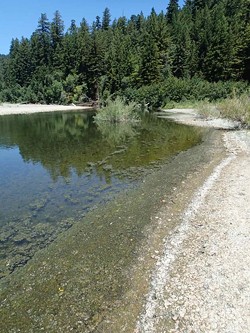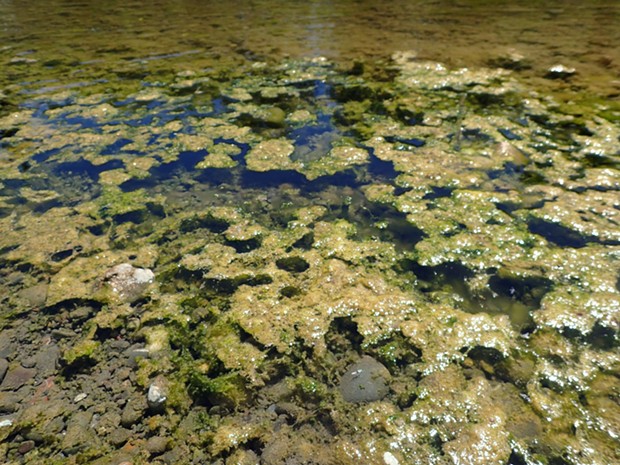Friday, September 6, 2024
Officials Urge Caution After 2 Dogs Die Following Swim By Fernbridge
Posted By Kimberly Wear @kimberly_wear on Fri, Sep 6, 2024 at 12:41 PM
With two dogs having died shortly after swimming in a small pool of water by the Eel River near Fernbridge on Thursday, environmental health officials are urging the public to keep an eye out for potentially toxic algal blooms in local waterways.
“Warm water and abundant nutrients can cause cyanobacteria, sometimes called blue-green algae, to grow more rapidly than usual causing ‘blooms,’” a county Department of Health and Human Services press release states. “These blooms are termed ‘harmful algal blooms,’ or HABs, and can produce toxins and taste and odors that cause health risks to humans and animals.”
While the blooms can appear as “dark green, blue-green, black, orange or brown water or can occur as mats and sometimes create scum or foam on the riverbed or on the water,” the “toxins produced by HABs may be present without visual indicators,” according to the release.
Warnings about cyanobacteria are a yearly occurrence, generally in late July to early August, “coinciding with low flows and sustained high temperatures in the inland areas, which may contribute to cyanobacteria growth in local rivers and lagoons,” DHHS states.
Over the last two decades, the deaths of 12 dogs have been documented as having occurred shortly after the animals went swimming in Big Lagoon, the South Fork Eel River or the Van Duzen River, with water samples confirming the presence of HAB in each of those cases. A documented July 2021 bloom in the Trinity River east of Willow Creek is also believed to have contributed to another dog’s death, the release states.
In most cases, green algae in local waterways is harmless, but environmental health officials are urging the public to treat all blooms as having “the potential to contain toxins,” noting “it is difficult to test and monitor the many miles of local rivers with conditions that readily change.”
Officials offered the following recommendations:
Blooms can also be reported on the free app “bloomWatch” app on iTunes or Google play. For information on conditions in Humboldt County, contact the Humboldt County Department of Health and Human Services Division of Environmental Health at (707) 445-6215 or (800) 963-9241. Photos of suspected blooms can be emailed to [email protected].
“Warm water and abundant nutrients can cause cyanobacteria, sometimes called blue-green algae, to grow more rapidly than usual causing ‘blooms,’” a county Department of Health and Human Services press release states. “These blooms are termed ‘harmful algal blooms,’ or HABs, and can produce toxins and taste and odors that cause health risks to humans and animals.”
While the blooms can appear as “dark green, blue-green, black, orange or brown water or can occur as mats and sometimes create scum or foam on the riverbed or on the water,” the “toxins produced by HABs may be present without visual indicators,” according to the release.
Warnings about cyanobacteria are a yearly occurrence, generally in late July to early August, “coinciding with low flows and sustained high temperatures in the inland areas, which may contribute to cyanobacteria growth in local rivers and lagoons,” DHHS states.
Over the last two decades, the deaths of 12 dogs have been documented as having occurred shortly after the animals went swimming in Big Lagoon, the South Fork Eel River or the Van Duzen River, with water samples confirming the presence of HAB in each of those cases. A documented July 2021 bloom in the Trinity River east of Willow Creek is also believed to have contributed to another dog’s death, the release states.
In most cases, green algae in local waterways is harmless, but environmental health officials are urging the public to treat all blooms as having “the potential to contain toxins,” noting “it is difficult to test and monitor the many miles of local rivers with conditions that readily change.”
Officials offered the following recommendations:
- Keep children, pets and livestock from swimming in or drinking water containing algal scums or mats — especially those occurring in slow or stagnant water.
- Rinse your dog with clean water after swimming as toxins may still be present on their fur.
- Adults should also avoid wading and swimming in water containing algal blooms. Try not to swallow or inhale water spray in an algal bloom area.
- If no algal scums or mats are visible, you should still carefully watch young children, warn them not to swallow any water and bathe with clean water after swimming.
- Fish should be consumed only after removing the guts and liver and rinsing filets in tap water.
- Never drink, cook with or wash dishes with water from rivers, streams or lakes.
- Get medical attention immediately if you think that you, your pet or livestock might have been poisoned by cyanobacteria toxins. Be sure to tell the doctor or veterinarian about possible contact with cyanobacteria or algal blooms.
- Join or support one of the many watershed and river organizations.
Blooms can also be reported on the free app “bloomWatch” app on iTunes or Google play. For information on conditions in Humboldt County, contact the Humboldt County Department of Health and Human Services Division of Environmental Health at (707) 445-6215 or (800) 963-9241. Photos of suspected blooms can be emailed to [email protected].
Speaking of...
-

Birding with Dogs
Sep 14, 2023 - More »
Readers also liked…
more from the author
-
ECS Board Directs Staff Back to CHP on Jacobs Sale
- Sep 5, 2024
-
Sequoia Park Zoo Says Sad Good-bye to Sumo, the 'Original Red Panda'
- Aug 21, 2024
-
VTY, Not Rob Arkley
- Aug 15, 2024
- More »

































